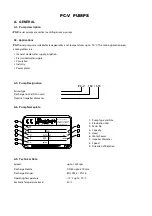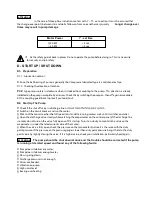
POSSIBLE CAUSES
There may be air existing in pump or
suction pipe
Ingress of air through shaft seal,
suction pipe or suction port. Pump
lifts liquid with air
Air pocket in the suction pipe.
There is air in liquid
Too much suction lift
Pump is working at cavitation
conditions
Insufficient manometric head.
Increase at total manometric head.
Pump is operating at lower
manometric head.
Reverse rotation.
Speed is too low.
Speed is too high.
Impeller or check valve or strainer is
clogged.
Impeller or strainer is clogged partially.
Partially clogged impeller.
Worn out and defected impeller.
Mechanical frictions inside the pump.
Excess tightened soft packing.
Bad coupling alignment.
Bearing covers are too tight.
The pumped flow is less than the
minimum flow required.
Existence of excess grease.
Oblique shaft.
Insufficient lubrication or lubricating
oil/grease dirty, contaminated.
Unbalanced rotating parts.
Pump runs out of duty range.
The density or viscosity of the liquid
pumped is higher than that originally
specified.
Defects in motor.
Check the slope of the suction line make sure that there is no reason
for formation of air pockets
Suction pipe is not submerged enough creating vortex. Check liquid
level in suction tank or increase the depth of suction pipe or foot valve
in the liquid.
If no obstruction at inlet check the friction losses of suction line, larger
piping may correct condition. If static lift is too high, the liquid level in
the suction tank must be raised or the pump lowered.
NPSH available is too low. Check liquid level in suction tank, check
suction line for excessive friction losses. Check isolating valve in
suction line to make sure it is completely open. If necessary increase
suction head on pump by lowering the pump.
The actual total head is higher than that originally specified. Check the
geodetic total head and friction losses in the discharge line. Larger
piping may correct the condition. Check that valves are fully open.
Check that valves are fully open. Check that there is any obstruction in
discharge pipe.
The actual total head is lower than that originally specified. Machine
impeller outer diameter to size advised by supplier.
Check motor rotation with directional arrow on pump casing or
nameplate.
Check the supply voltage and frequency or motor may have open phase.
If possible decrease the pump rotational speed or turn down the impeller
outer diameter to size advised by supplier.
Clean the impeller or check valve or strainer
Clean the impeller or strainer.
Clean the impeller.
Replace impeller.
Check pump rotor for any rotor obstruction or deflection.
Loosen the nuts of the packing gland.
Check the coupling rubber and realign the coupling.
Check and make necessary modification on the cover.
Increase the flow. If necessary use by-pass recirculating valve or line.
Remove excess grease.
Check the shaft and replace it if necessary.
Check the amount of oil/grease. Clean the bearings and bearing
housing and relubricate
Check the balance of the rotating parts.
Check the values of operating point.
Use a more powerful motor.
Check any motor defects. The motor may not be ventilated properly
due to a poor location.
1
2
3
4
5
6
7
8
9
10
11
12
13
14
15
16
17
18
19
20
21
22
23
24
25
26
27
28
REMEDIES
Check for leaks in suction pipe joints and fittings. Check shaft seal if
necessary increase the pressure of sealing liquid. Check the dept of
suction pipe or foot valve in the liquid and if necessary increase the
depth of them.
Fill pump and suction pipe completely with liquid and repeat the priming
procedure.



































